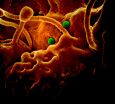(Press-News.org) Stroke is one of the leading causes of death worldwide. While many lines of evidence suggest that stroke risk is heritable, only a small number of genes associated with stroke have been identified. A new study in the Journal of Clinical Investigation identifies two genes that underlie cerebral small-vessel disease (CSVD), a risk factor for stroke. Ordan Lehmann and colleagues at the University of Alberta analyzed genome-wide association data from individuals that received brain MRI scans as part of the Cohorts for Heart and Aging Research in Genomic Epidemiology (CHARGE) study. Patients with mutations that reduced expression of a protein involved with brain development, FOXC1, exhibited signs of CSVD. In zebrafish, reducing Foxc1 levels mimicked symptoms of CSVD, including cerebellar hemorrhage. Lehmann and colleagues also found that patients with mutations that reduced expression of a protein that interacts with FOXC1, PITX2, also exhibit CSVD. Further, deletion of Pitx2 in mouse models resulted in defects in brain vasculature. Thus, this study identifies two genes that underlie development of the stroke risk factor CSVD.
INFORMATION:
TITLE:
Mutation of FOXC1 and PITX2 induces cerebral small-vessel disease
AUTHOR CONTACT:
Ordan Lehmann
University Of Alberta, Edmonton, AB, CAN
Phone: 780-492-8550; E-mail: olehmann@ualberta.ca
View this article at: http://www.jci.org/articles/view/75109?key=d8a0e6b1877586969a09
Identification of genetic risk factors for stroke
2014-09-25
ELSE PRESS RELEASES FROM THIS DATE:
Wound healing response promotes breast cancer metastasis in postpartum mice
2014-09-25
Within the first 5 years after the birth of a child, women are at an increased risk of developing metastatic breast cancer. Women diagnosed with postpartum breast cancer have a decreased disease free survival time compared to women that have never given birth. The aggressive tendency of postpartum breast cancer suggests that the post-birth breast environment promotes tumor metastasis. A new study in the Journal of Clinical Investigation, suggests that dying tumor cells in postpartum breast tissue promote metastatic disease. Rachel Cook and colleagues at Vanderbilt University ...
Memory slips may signal increased risk of dementia years later
2014-09-24
MINNEAPOLIS – New research suggests that people without dementia who begin reporting memory issues may be more likely to develop dementia later, even if they have no clinical signs of the disease. The study is published in the September 24, 2014, online issue of Neurology®, the medical journal of the American Academy of Neurology.
"What's notable about our study is the time it took for this transition to dementia or clinical impairment to occur—about 12 years for dementia and nine years for clinical impairment—after the memory complaints began," said study author Richard ...
Think you have Alzheimer's? You just might be right, study says
2014-09-24
LEXINGTON, Ky. (Sept. 24, 2014) -- New research by scientists at the University of Kentucky's Sanders-Brown Center on Aging suggests that people who notice their memory is slipping may be on to something.
The research, led by Richard Kryscio, PhD, Chairman of the Department of of Biostatistics and Associate Director of the Alzheimer's Disease Center at the University of Kentucky, appears to confirm that self-reported memory complaints are strong predictors of clinical memory impairment later in life.
Kryscio and his group asked 531 people with an average age of 73 ...
Clinical trial examined treatment for complicated grief in older individuals
2014-09-24
Bottom Line: A treatment designed to help older individuals deal with complicated grief (CG) after the loss of a loved one appeared to be more effective than using a treatment designed for depression.
Authors: M. Katherine Shear, M.D., of the Columbia University School of Social Work, New York, and colleagues.
Background: About 9 percent of bereaved older women experience CG, a serious and debilitating mental health problem associated with functional impairment and increased suicidality. The symptoms can include prolonged grief, frequent thoughts and memories of the ...
Family-based therapies can treat anorexia in teens, Stanford/Packard study finds
2014-09-24
Two different family-based therapies are both effective at combating anorexia nervosa in teenagers, according to the largest study ever to compare two such treatments for the life-threatening eating disorder.
The findings, from a multisite study led by researchers at the Stanford University School of Medicine, add to a growing body of evidence supporting the value of parents' involvement in anorexia treatment.
The results, which will be published Sept. 24 in JAMA Psychiatry, follow prior Stanford research that found a family-based approach was twice as effective as ...
NIH study supports camels as primary source of MERS-CoV transmission
2014-09-24
National Institutes of Health (NIH) and Colorado State University (CSU) scientists have provided experimental evidence supporting dromedary camels as the primary reservoir, or carrier, of Middle East respiratory syndrome coronavirus (MERS-CoV). The study, designed by scientists from CSU and NIH's National Institute of Allergy and Infectious Diseases, involved three healthy camels exposed through the eyes, nose and throat to MERS-CoV isolated from a patient. Each camel developed a mild upper respiratory tract infection consistent with what scientists have observed throughout ...
When David beats Goliath
2014-09-24
Body size has long been recognized to play a key role in shaping species interactions, with larger species usually winning conflicts with their smaller counterparts. But Queen's University biologist Paul Martin has found that occasionally, small species of birds can dominate larger species during aggressive interactions, particularly when they interact with distantly related species.
The new findings provide evidence that the evolution of certain traits can allow species to overcome the disadvantage of a smaller size.
"We want to understand why species live where they ...
First mouse model for ALS dementia
2014-09-24
CHICAGO --- The first animal model for ALS dementia, a form of ALS that also damages the brain, has been developed by Northwestern Medicine® scientists. The advance will allow researchers to directly see the brains of living mice, under anesthesia, at the microscopic level. This will allow direct monitoring of test drugs to determine if they work.
This is one of the latest research findings since the ALS Ice Bucket Challenge heightened interest in the disease and the need for expanded research and funding.
"This new model will allow rapid testing and direct monitoring ...
Findings give hope to plant extract as possible lupus treatment
2014-09-24
HOUSTON, Sept. 24, 2014 – New findings by a biomedical engineer and his team at the University of Houston (UH) raise hope for a new class of drugs to treat lupus that may not include the long list of adverse risks and side effects often associated with current treatments for this disease.
Lupus, or systemic lupus erythematosus, is a progressive, degenerative disease in which the immune system turns against itself, attacking a person's healthy tissue, cells and organs. Symptoms range from debilitating pain and fatigue to organ failure and a host of other impairments. ...
Captive whooping cranes released into the wild
2014-09-24
NECEDAH, Wis. – Four whooping crane chicks raised in captivity began their integration into the wild Saturday as part of the continuing effort to increase the wild population of this endangered species.
The cranes, hatched and raised by their parents at the U.S. Geological Survey's Patuxent Wildlife Research Center in Laurel, Maryland, were released on the U.S. Fish and Wildlife Service's Necedah National Wildlife Refuge in Wisconsin.
The chicks, about six-months old, are part of an experimental rearing and release method referred to as "parent-rearing." The parent-reared ...


